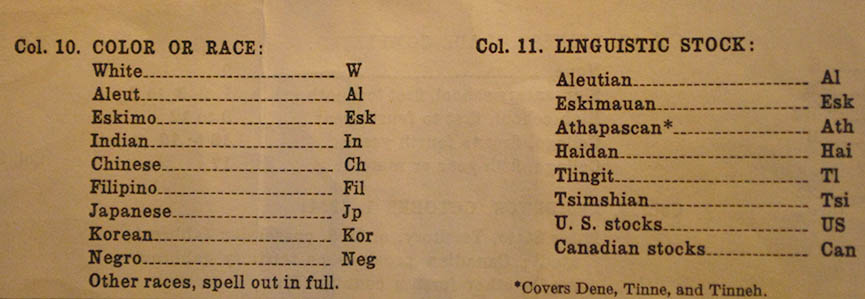The Imaginary Partners of Alaska
 Since my last post, I’ve discovered more about how Census Bureau officials trained census takers to label adults living together as “partners.” They wrote census stories.
Since my last post, I’ve discovered more about how Census Bureau officials trained census takers to label adults living together as “partners.” They wrote census stories.
Like this one:
“The next household enumerated was No. 101 Fifth Street, where two native Haidan Indians, John Harris, aged 43, and Edward Brown, aged 42, operate a cigar store. John is the proprietor and owner of the building and Edward is a clerk in the store. They have operated this store during the past 5 years. John pays Edward $5 per week plus his room and board. They live in a back room in the building in which the store is located. John was graduated from the Juneau High School, but Edward left school after he had completed from the seventh grade. John told the enumerator that neither he nor Edward had ever been married.” (Emphasis added.)
During their training, enumerators charged with counting Alaskans encountered this story on a salmon-colored form that illustrated one of their central tasks as census takers: translating personal stories into tabular rows of data. The image above shows the right answer—–the official translation for the story of the imaginary John Harris and Edward Brown.
Alaska remained a territory for another 20 years after these enumerators swept through in 1939 (a year before the census in the states). For that reason, the “Division of Territorial, Insular, and Foreign Statistics” administered the census in Alaska and generated a parallel universe of forms. They looked a lot like all the other census forms, but they differed in ways that reflected U.S. government’s ideas about what made Alaska and other territories or imperial possessions peculiar. Alaska’s forms—as the following snippet suggests—devoted much energy to classifying Native peoples according to both “Color or Race” and “Linguistic Stock,” on the advice of, among others, the Smithsonian anthropologist Ales Hrdlicka.

In this context, the Division of Territorial, Insular, and Foreign Statistics invented a pair of literal “cigar store Indians” (Harris and Brown) to illustrate the use of the “partner” category. Commercial culture (the cigar store Indian as marketing tool) met elite intellectual life of the early-twentieth century (scientific racism and physical anthropology) on the census schedule grid—all to try to make sense of unmarried people and same-sex couples within the United States’ colonizing project.
Appendix: For the mainland 1940 census, Bureau officials made up a couple who would have fit nicely in the Greenwich village sample: two women—a music teacher and a librarian— both in their early thirties, college educated, and living together.
